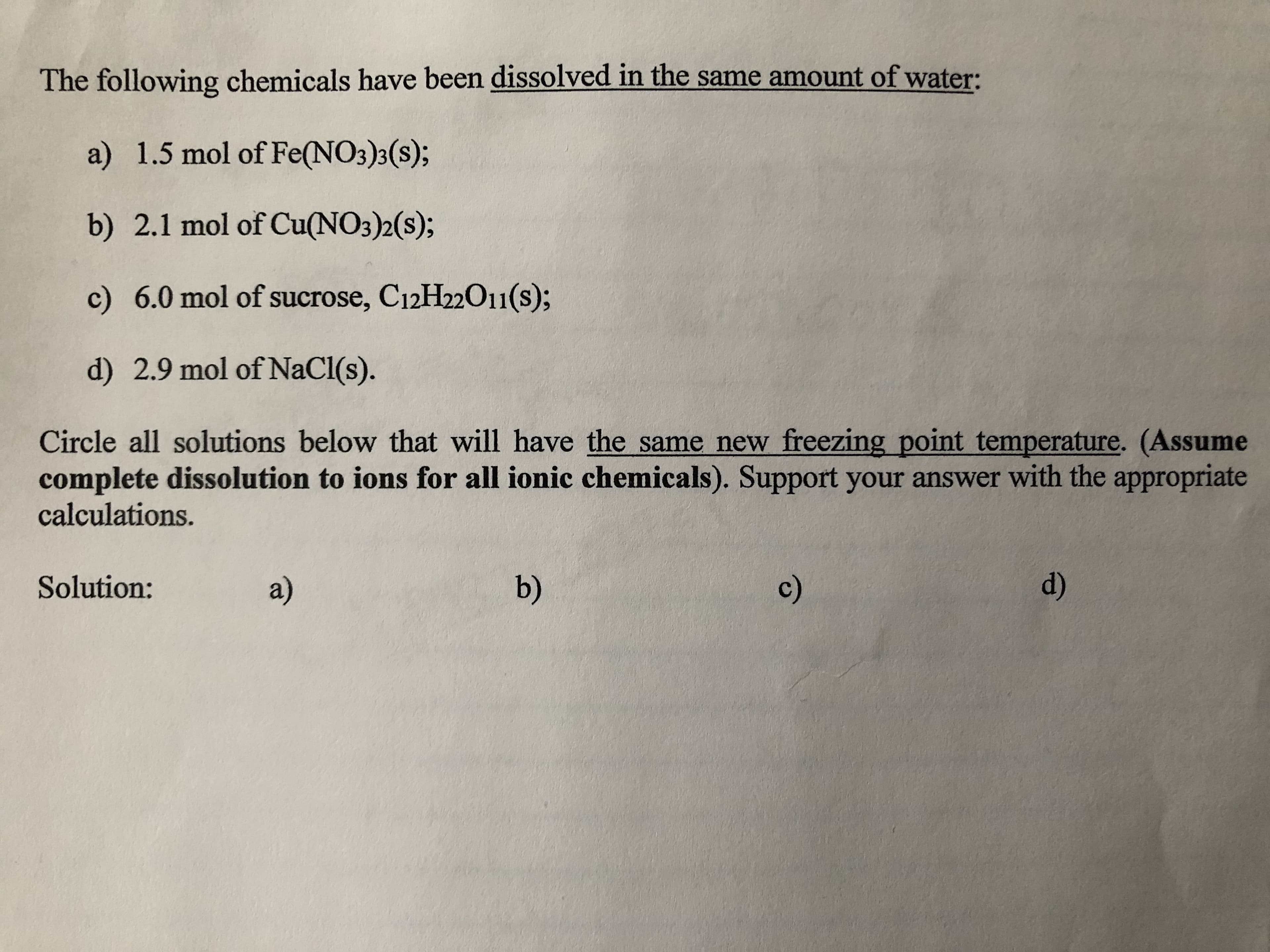The folloving chemicals have been disslved in the same amount of water- issolved in the a) 1.5 mol of Fe(NO3)3(s); b) 2.1 mol of Cu(NO3)2(s); c) 6.0 mol of sucrose, C1H2011(s) d) 2.9 mol of NaCI(s). Circle all solutions below that will have the same new freezing point temperature. (Assume complete dissolution to ions for all ionic chemicals). Support your answer with the appropriate calculations Solution: a) b) c) d)
The folloving chemicals have been disslved in the same amount of water- issolved in the a) 1.5 mol of Fe(NO3)3(s); b) 2.1 mol of Cu(NO3)2(s); c) 6.0 mol of sucrose, C1H2011(s) d) 2.9 mol of NaCI(s). Circle all solutions below that will have the same new freezing point temperature. (Assume complete dissolution to ions for all ionic chemicals). Support your answer with the appropriate calculations Solution: a) b) c) d)
Chemistry & Chemical Reactivity
9th Edition
ISBN:9781133949640
Author:John C. Kotz, Paul M. Treichel, John Townsend, David Treichel
Publisher:John C. Kotz, Paul M. Treichel, John Townsend, David Treichel
Chapter13: Solutions And Their Behavior
Section13.4: Colligative Properties
Problem 7CYU: Calculate the freezing point of 525 g of water that contains 25.0 g of NaCl. Assume i, the vant Hoff...
Related questions
Question
Can you please help me determine all the solutions (a, b, c, and/or d) with the appropriate calculations?

Transcribed Image Text:The folloving chemicals have been disslved in the same amount of water-
issolved in the
a) 1.5 mol of Fe(NO3)3(s);
b) 2.1 mol of Cu(NO3)2(s);
c) 6.0 mol of sucrose, C1H2011(s)
d) 2.9 mol of NaCI(s).
Circle all solutions below that will have the same new freezing point temperature. (Assume
complete dissolution to ions for all ionic chemicals). Support your answer with the appropriate
calculations
Solution:
a)
b)
c)
d)
Expert Solution
This question has been solved!
Explore an expertly crafted, step-by-step solution for a thorough understanding of key concepts.
This is a popular solution!
Trending now
This is a popular solution!
Step by step
Solved in 7 steps with 5 images

Knowledge Booster
Learn more about
Need a deep-dive on the concept behind this application? Look no further. Learn more about this topic, chemistry and related others by exploring similar questions and additional content below.Recommended textbooks for you

Chemistry & Chemical Reactivity
Chemistry
ISBN:
9781133949640
Author:
John C. Kotz, Paul M. Treichel, John Townsend, David Treichel
Publisher:
Cengage Learning

Chemistry for Today: General, Organic, and Bioche…
Chemistry
ISBN:
9781305960060
Author:
Spencer L. Seager, Michael R. Slabaugh, Maren S. Hansen
Publisher:
Cengage Learning

General Chemistry - Standalone book (MindTap Cour…
Chemistry
ISBN:
9781305580343
Author:
Steven D. Gammon, Ebbing, Darrell Ebbing, Steven D., Darrell; Gammon, Darrell Ebbing; Steven D. Gammon, Darrell D.; Gammon, Ebbing; Steven D. Gammon; Darrell
Publisher:
Cengage Learning

Chemistry & Chemical Reactivity
Chemistry
ISBN:
9781133949640
Author:
John C. Kotz, Paul M. Treichel, John Townsend, David Treichel
Publisher:
Cengage Learning

Chemistry for Today: General, Organic, and Bioche…
Chemistry
ISBN:
9781305960060
Author:
Spencer L. Seager, Michael R. Slabaugh, Maren S. Hansen
Publisher:
Cengage Learning

General Chemistry - Standalone book (MindTap Cour…
Chemistry
ISBN:
9781305580343
Author:
Steven D. Gammon, Ebbing, Darrell Ebbing, Steven D., Darrell; Gammon, Darrell Ebbing; Steven D. Gammon, Darrell D.; Gammon, Ebbing; Steven D. Gammon; Darrell
Publisher:
Cengage Learning

Chemistry: The Molecular Science
Chemistry
ISBN:
9781285199047
Author:
John W. Moore, Conrad L. Stanitski
Publisher:
Cengage Learning


Chemistry & Chemical Reactivity
Chemistry
ISBN:
9781337399074
Author:
John C. Kotz, Paul M. Treichel, John Townsend, David Treichel
Publisher:
Cengage Learning